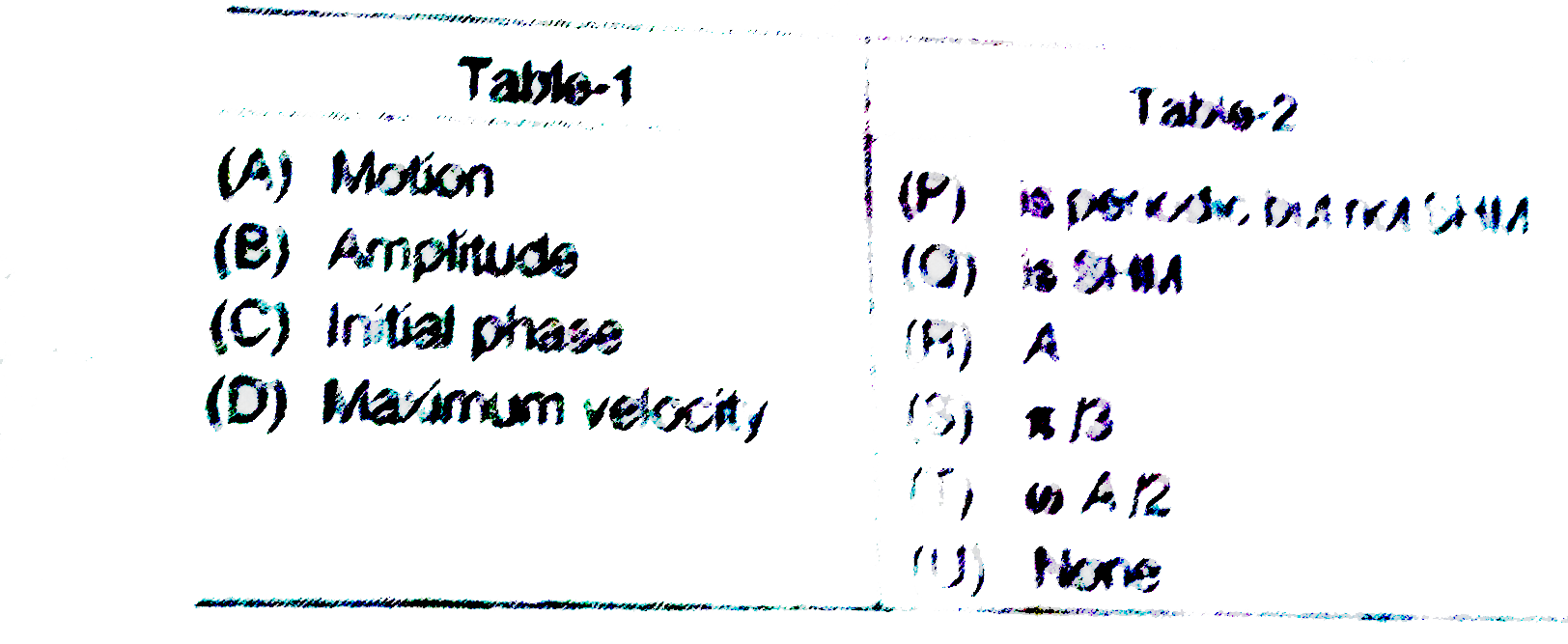Following are equations of four waves :
(i) y1=asinω(t−xv)
(ii) y2=acosω(t+xv)
(iii) z1=asinω(t−xv)
(iv) z1=acosω(t+xv)
Which of the following statements are correct ?
On superposition of waves (i) and (iii) , a travelling wave having amplitude a√2 will be formed
Superposition of waves (ii) and (iii) is not possible
On superposition of waves (i) and (ii) , a travelling wave having amplitude a√2 will be formed
On superposition of (iii) and (iv) , a transverse stationary wave will be formed
The correct Answer is:A, D
To analyze the given equations of the waves and determine which statements are correct, we will go through the equations step by step.
Step 1: Identify the Waves
The equations of the waves provided are:
1. y1=asin(ω(t−xv))
2. y2=acos(ω(t+xv))
3. z1=asin(ω(t−xv))
4. z2=acos(ω(t+xv))
Step 2: Analyze the Waves
- Wave 1 and Wave 3: Both are sine waves traveling in the positive x-direction.
- Wave 2 and Wave 4: Both are cosine waves traveling in the negative x-direction.
Step 3: Superposition of Waves
1. Superposition of y1 and y2:
- y1 travels in the positive x-direction and y2 travels in the negative x-direction.
- Since they are traveling in opposite directions, they will form a standing wave.
- The resultant amplitude can be calculated using the Pythagorean theorem since they are 90 degrees out of phase (sine and cosine).
- Resultant Amplitude: Aresultant=√a2+a2=a√2.
2. Superposition of y2 and z3:
- y2 (cosine) and z3 (sine) cannot be superimposed directly as they are not traveling in opposite directions. They will not form a standing wave.
3. Superposition of y1 and z2:
- Similar to the first case, y1 and z2 will also form a standing wave since they are traveling in opposite directions.
- The resultant amplitude will also be a√2.
4. Superposition of z1 and z2:
- z1 and z2 are both sine and cosine waves traveling in opposite directions.
- They will form a standing wave as well.
Step 4: Conclusion
Based on the analysis:
- Statement A: True, a traveling wave is formed from y1 and y2 with the resultant amplitude a√2.
- Statement B: False, superposition of y2 and z3 is possible.
- Statement C: False, the superposition of y1 and y2 does not yield a traveling wave.
- Statement D: True, a transverse wave is formed from z1 and z2.
Final Answer
The correct statements are A and D.
The equations of the waves provided are:
1. y1=asin(ω(t−xv))
2. y2=acos(ω(t+xv))
3. z1=asin(ω(t−xv))
4. z2=acos(ω(t+xv))
- Wave 1 and Wave 3: Both are sine waves traveling in the positive x-direction.
- Wave 2 and Wave 4: Both are cosine waves traveling in the negative x-direction.
1. Superposition of y1 and y2:
- y1 travels in the positive x-direction and y2 travels in the negative x-direction.
- Since they are traveling in opposite directions, they will form a standing wave.
- The resultant amplitude can be calculated using the Pythagorean theorem since they are 90 degrees out of phase (sine and cosine).
- Resultant Amplitude: Aresultant=√a2+a2=a√2.
- y2 (cosine) and z3 (sine) cannot be superimposed directly as they are not traveling in opposite directions. They will not form a standing wave.
- Similar to the first case, y1 and z2 will also form a standing wave since they are traveling in opposite directions.
- The resultant amplitude will also be a√2.
- z1 and z2 are both sine and cosine waves traveling in opposite directions.
- They will form a standing wave as well.
Based on the analysis:
- Statement A: True, a traveling wave is formed from y1 and y2 with the resultant amplitude a√2.
- Statement B: False, superposition of y2 and z3 is possible.
- Statement C: False, the superposition of y1 and y2 does not yield a traveling wave.
- Statement D: True, a transverse wave is formed from z1 and z2.
The correct statements are A and D.
Topper's Solved these Questions
- BOOK - CENGAGE PHYSICS ENGLISHCHAPTER - SUPERPOSITION AND STANDING WAVESEXERCISE - Assertion - Reasoning6videos
SUPERPOSITION AND STANDING WAVES
- BOOK - CENGAGE PHYSICS ENGLISHCHAPTER - SUPERPOSITION AND STANDING WAVESEXERCISE - Comprehension55videos
SUPERPOSITION AND STANDING WAVES
- BOOK - CENGAGE PHYSICS ENGLISHCHAPTER - SUPERPOSITION AND STANDING WAVESEXERCISE - Single Correct144videos
SUPERPOSITION AND STANDING WAVES
- BOOK - CENGAGE PHYSICS ENGLISHCHAPTER - SOUND WAVES AND DOPPLER EFFECTEXERCISE - Integer16videos
SOUND WAVES AND DOPPLER EFFECT
- BOOK - CENGAGE PHYSICS ENGLISHCHAPTER - THERMODYNAMICSEXERCISE - 241videos
THERMODYNAMICS
Similar Questions
If i1=3sinωtand(i2)=4cosωt, then (i3) is
 View Solution
View SolutionFour sound sources produce the following four waves
(i) y1=asin(ωt+ϕ1)
(ii) y2=asin2ωt
(iii) y3=a'sin(ωt+ϕ2)
(iv) y4=a'sin(3ωt+ϕ)
Superposition of which two waves gives rise to interference?View SolutionThe following equations represent progressive transverse waves
z1=Acos(ωt−kx)
z2=Acos(ωt+kx)
z3=Acos(ωt+ky)
z4=Acos(2ωt−2ky)
A stationary wave will be formed by superposingView SolutionIn y= A sin ωt + A sin (ωt+(2π)/3) match the following table.
 View Solution
View SolutionConsider the three waves z1,z2andz3 as
z1=Asin(kx−ωt)
z2=Asin(kx+ωt)
z3=Asin(ky−ωt)
Which of the following represents a standing wave?View Solutionx1=5sinωt
x2=5sin(ωt+53∘)
x3=−10cosωt
Find amplitude of resultant SHM.View Solutionx1=5sinωt
x2=5sin(ωt+53∘)
x3=−10cosωt
Find amplitude of resultant SHM.View SolutionThe path difference between the two waves
y1=a1sin(ωt−2πxλ)andy(2)=a2cos(ωt−2πxλ+ϕ) isView SolutionThe path difference between the two waves
y1=a1sin(ωt−2πxλ)andy(2)=a2cos(ωt−2πxλ+ϕ) isView Solutionx1=3sinωt,x2=4cosωt
Find (i) amplitude of resultant SHM, (ii) equation of the resultant SHM.View Solution

